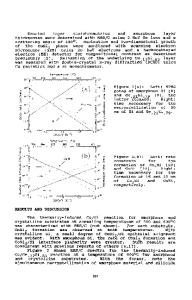Enhanced remanence in nanocomposite of Y 1-x Sm x Co 5 /Co ribbons obtained by melt-spinning
- PDF / 905,043 Bytes
- 7 Pages / 612.12 x 792.12 pts Page_size
- 18 Downloads / 333 Views
Enhanced remanence in nanocomposite of Y1-xSmxCo5/Co ribbons obtained by meltspinning José L. Hidalgo1. Maria C. Grijalva2, José A. Matutes2, Carlos W. Orquiz3, Fernando L. De Araujo 4. Francisco A. Olímpio 5. 1 Instituto Tecnológico Superior de Poza Rica, Calle. Luis Donaldo Colosio S/N. Col. Arroyo del Maíz. C.P. 93230 Poza Rica, Veracruz – México. 2 Centro de Investigación en Materiales Avanzados, S. C., Miguel de Cervantes 120, Complejo Industrial Chihuahua, 3112, Chihuahua, Chihuahua - México. 3 Universidad Politécnica de la Región Ribereña. Libramiento Lázaro Cárdenas del Río # 325, Col Américo Villarreal Miguel Alemán, Tamaulipas. 4 Departamento de Física, Universidade Federal de Pernambuco, 50670-901 Recife-PE, Brazil. 5 Departamento de geofísica. Universidade Federal do Rio Grande do Norte, 59072-970 Natal-RN, Brazil
ABSTRACT The synthesis of alloys with nominal composition for Y1-xSmxCo5 by means of arc furnace and melt-spinning, is of critical scientific importance due that if replaced partially or completely the Samarium by the Yttrium is possible understand what contribution the earth element rare to the exchange interactions that guide to increased remnant magnetization in a nanocomposite. The alloys of Y1-xSmxCo5/Co obtained by melt-spun were characterized by x-ray diffraction with a compact hexagonal crystal structure the CaCu5 type. The alloys for nanocomposites of Y1xSmxCo5/Co ribbons show ferromagnetic behavior with good magnetic properties, order to demonstrate this the magnetic properties were measured using a pulsed field magnetometer applying a high magnetic field in order to obtain a saturated magnetization curve and a high coercivity of 0.69 MA/m and an enhanced remanence of σr/σsat ratio equal to 0.57 were determined.
INTRODUCTION Enhanced remanence due to the exchange interactions, along with a refined microstructure strongly influence the magnetic properties of nanocomposites composed of two phases, magnetically hard and soft phases, where the magnetically hard phase provides a high uniaxial anisotropy which is obtained from the intermetallic compounds with a packed hexagonal crystal structure of CaCu5 type, wherein Ca represents the rare earth elements, while that Cu represents the transition metals [1]. Similarly will be necessary in these nanocomposites a high saturation magnetization that is provided by the magnetically soft phase obtained of the transition metals such as Fe with a cubic crystal structure face-centered, therefore it is important to mention that for these nanocomposites is necessary that the nanograins size of the magnetically soft phase is in the range of 20 to 50 nm for optimizing the magnetic properties of the nanocomposites [2]. It is also important to mention that the two-phase nanocomposites have greatly attracted attention because of their potential use as permanent magnets and their applications as data storage media of high density [3]. Good magnetic properties can be obtained in nanocrystalline alloys produced through different synthesis processes such as,
Data Loading...











